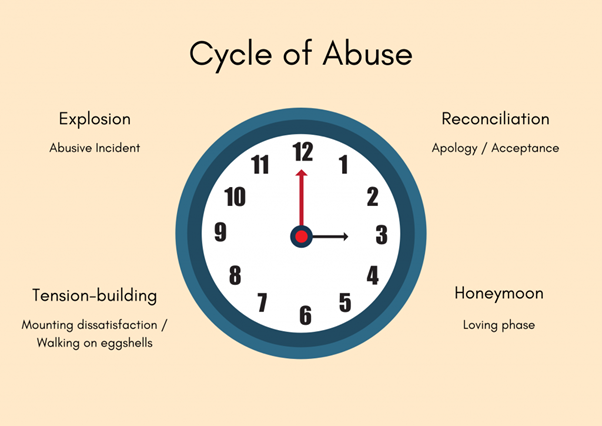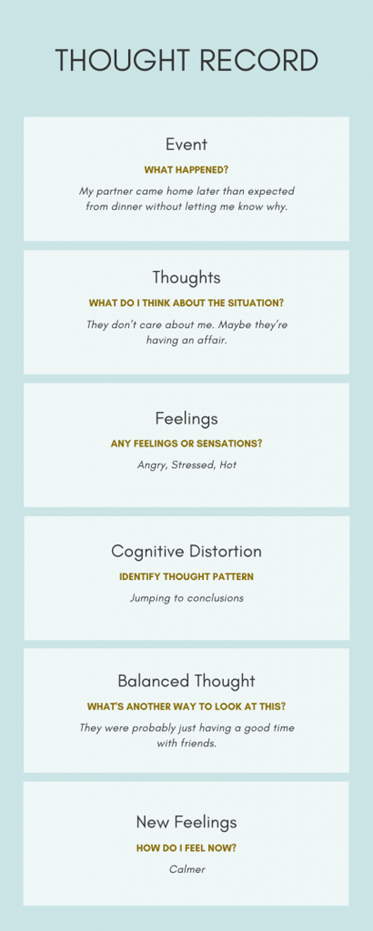
Family Violence Counselling?
I recognise the complexities of family violence, including living in fear and intimidation, and its impacts. Family violence affects people of every community, age, gender and sexual preference throughout Australia. While family violence can happen in many different family relationships, it is overwhelmingly women and children who are affected by violence, and men who use it. I acknowledge the difficulties women experiences, to leave the relationship and significant psychological, emotional, and physical impacts on those who are directly affected by abuse and on those who witness the violence. My counselling approach involves working with clients who are in the relationship and also providing intensive counselling to victim’s survivors to heal from the trauma experiences of family violence.
Family Violence Counselling ( While you are in Relationship)
The cycle of abuse explained Article by Mahlia Price in Marriage and Relationships, Sex and intimacy Perhaps you have “off” days. Overall, however, your relationship feels okay.
When abuse becomes our normal, we might not realise it’s happening. The cycle of abuse explains how the good days feed toxic relationships as much as the bad. Understanding the cycle of abuse can help you recognise destructive patterns in your relationship and make the change that needs to happen.
Why the cycle of abuse?
Many people have a hard time recognising abuse for what it is. In the early stages of a relationship, people often conceal abusive behaviours. Only once the bond has formed do problems tend to arise. Further, periods of harmony can distract us from what’s going on. Abuse comes in many forms. It can occur in any type of relationship, regardless of culture, sexuality, or gender identity. Though, in general, abuse is any behaviour that dominates through fear, including
- Verbal threats
- Sexual abuse
- Emotional manipulation
- Financial control
- Isolating a person from family, friends, or work
- Stalking, both on- and offline
- or give the “silent treatment”
- Express jealousy
- Manipulate others with language like, “You’re pushing it,” or “If you really loved me, you would…”
- Experience hopelessness or anxiety
- Feel like they’re “walking on eggshells”
- Become hyperalert to the perpetrator’s behaviour and moods
- Think they have done something wrong
- Ignore the problem
- Verbal abuse
- Physical abuse
- Sexual abuse
- Emotional abuse
- Financial abuse
While no two relationships are equal, the cycle of abuse provides a framework to clarify whether your relationship is abusive – even on the good days. If you are in crisis and need immediate advice to protect your safety, please go to our crisis resources section here [link it] for free crisis support lines or call 000.
What is the cycle of abuse?
The cycle of abuse originated in psychologist Lenore Walker’s 1979 book, The Battered Woman, where she argued that abuse tends to occur not in isolation, but in patterns that increase in severity overtime. The cycle of abuse describes four common phases in abusive relationships:
Honeymoon Phase
The honeymoon phase resembles the initial stages of a relationship. In abusive relationships, this phase tends to recur as part of a destructive pattern. The perpetrator of abuse seeks to create a renewed sense of harmony in the relationship. They are more attentive than usual, acting in ways their partner will appreciate. It might be loving words, compliments, or gifts.
The honeymoon phase feels good – a welcome reprieve from stress, fear, and anger – which is why it’s hard to recognise its destructive role. In abusive relationships, the honeymoon phase manipulates the survivor of abuse into forgetting or discrediting their experience. It encourages them to recall the warm feelings that had them enter the relationship in the first place.
The honeymoon phase doesn’t just occur in romantic relationships; it can occur in any relationship, whether with children, work colleagues, carers, elders, or friends. In these cases, the honeymoon phase encourages the survivor to associate a sense of security with the abuser.
Tension-building phase
The honeymoon phase cannot last forever. Eventually, tension starts to build. It can occur at any time. It can be a sudden or a gradual process. Perpetrators of abuse have many different triggers, including family troubles, work stress, or fatigue. Rather than address the root cause of their unhappiness, they tend to blame it on those around them. They might:
Explosion phase
The relationship can no longer sustain the tension. The perpetrator senses the relationship under threat – to regain control, they displace the tension through abuse – an explosion event occurs. The abuse isn’t always physical, but includes any behaviour that dominates through fear, including:
The survivor might come to believe they deserve the abuse. But the perpetrator alone is responsible for their actions.
Reconciliation phase
If the relationship is to survive, both parties need to find an explanation for the abuse, and why it won’t happen again.
The perpetrator of abuse might feel genuine remorse and seek forgiveness. They might apologise, cry, make excuses, and promise it won’t happen again.
If they are still invested in the relationship, the survivor wants to believe the perpetrator. Accepting the apology issues a break from emotional pain – and a way back to the honeymoon phase. They might feel hopeful that everything will be okay.

Repeat
The cycle of abuse repeats, and overtime, tends to evolve. Often it speeds up, whereas phases might increase in severity or disappear altogether. The explosion phase might become more frequent, and the honeymoon phase increasingly rare.
It can be helpful to visualise the phases on a clock face:
The phases in the cycle of abuse are not absolute but blurred. At times, you might feel you are in-between phases. The clock is a tool to help you locate and interpret your experiences.
Note that every relationship is different – abuse won’t always follow this pattern. If you suspect that you or someone you know is experiencing abuse, there are support services to help you.
The limitations of the cycle of abuse
The cycle of abuse generalises characteristics common to many abusive relationships. This is both its strength and weakness. It provides a broad framework that many can relate to, but some people find that their experiences don’t neatly map onto the cycle of abuse, if at all.
The cycle of abuse remains useful, with the following limitations in mind:
- We can’t always predict abuse. It can happen anytime – not just after a ‘tension-building’ phase.
- The cycle can be subtle – it may go unnoticed, though it tends to increase in severity overtime.
- The cycle of abuse originated to describe abuse perpetrated by men against women in heterosexual relationships. There is less research on abuse in lesbian, gay, and queer relationships.
How to Overcome the Cycle of Abuse
If you suspect you have perpetrated abuse, the best thing you can do, for yourself and those around you, is acknowledge the problem. Only by owning our behaviour can we own the change.
If you’re still not sure, ask yourself if:
- You are often angry
- Your anger affects your relationships
- Your emotions feel overwhelming
- You get angry over things others wouldn’t
- You resort to verbal or physical abuse to express your anger
Breaking free from destructive habits takes time. It’s a whole lot easier with additional support – like specialist counselling – but there are steps you can take now to start improving your responses.
Try the following exercises:
Communication Exercise
Once you have acknowledged the problem, you can start learning better ways to express yourself. Consider the following steps the next time you encounter a strong emotion:
- Identify the feeling – What triggered it? Is it connected to any unhappy memories?
- Think – What do you want to change? What’s a healthy solution?
- Communication – Organise a time to discuss the problem with your partner, friend, or family.
- Plan what you want to say – Write down your concerns. Consider other’s perspectives.
- Pause before responding – Try to think before speaking. There’s nothing wrong with taking your time.
- Reflect on the conversation – Was it productive? Did you try and force your opinion on others, or did you hear them out? Think about how you could improve.
Thought Records Exercise
Our thoughts shape our emotions, which shape our reactions in turn. Thought records are a practical tool to help you challenge angry thoughts.
Anger often arises because we have taken a narrow view of the situation. We default to negative explanations without supporting evidence. These negative thought patterns are what psychologists call cognitive distortions.
Thought records help us challenge cognitive distortions and take on a more reasonable perspective.
You can read more about thought records, and how they are used in therapy here.
Consider the following example:

Thought Record
By documenting your experiences, you can achieve a more balanced perspective, one that focuses less on negative, and more on positive factors.
The more you practice thought records, the better you will become at responding productively.
Help Lines:
1800RESPECT is a free domestic violence counselling service open 24 hours, 7 days
a week.
P: 1800 737 732
Its app Daisy, available on Google Play and the App Store, connects people to local services, including financial, legal, housing and children’s services.
Kids Helpline is a free counselling service for people aged 5 to 25.
P: 1800 551 800
Lifeline is a free counselling service that helps people experiencing domestic
violence.
P: 131 114
Family Relationship Advice assists with family issues, including separation and
domestic violence.
P: 1800 050 321
The Elder Abuse Help Line provides free information and support. The Service
Finder can help you find services in your area
P: 1800 353 374
Compass provides information on elder abuse and can help you find local support
services.
website: https://www.compass.info/
Women with disability
Sunny, available on Google Play and the App Store, is an app made by women with a
disability for women with a disability.
MensLine Australia provides support to both survivors and perpetrators of violence
perpetrators, online and over the phone
P: 1300 789 978.
Men’s Referral Service is a free counselling and referral service to help men stop
using violence, available online at the No to Violence website and over the phone.
P: 1300 766 491
Financial Aid
Money Smart helps people regain financial control. It provides information
on divorce and separation and urgent money help.
Financial Counselling Australia offers free financial counselling to help people
experiencing domestic violence.
P: 1800 007 007.
